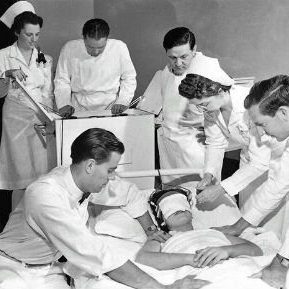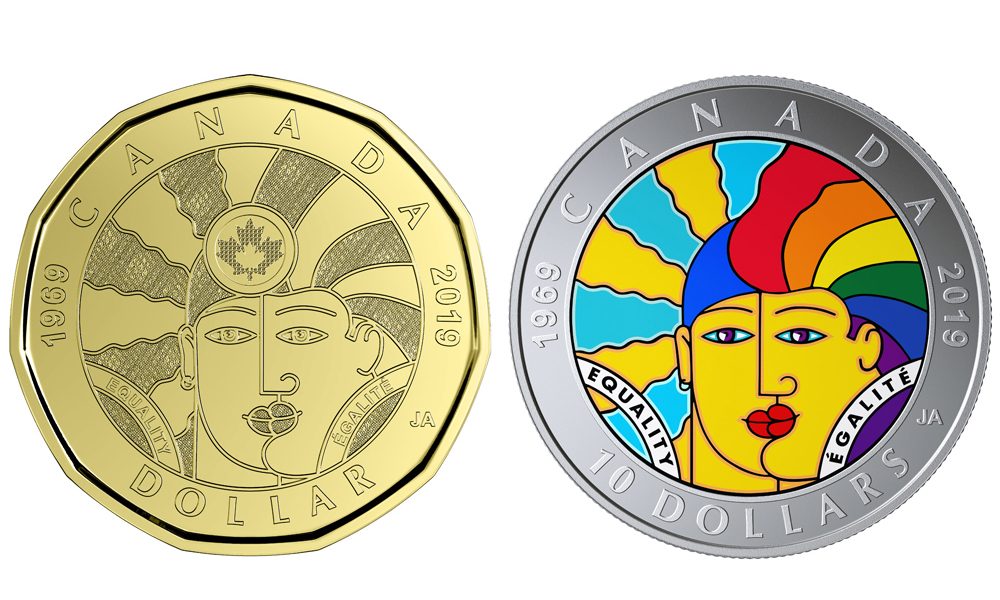 The Royal Canadian Mint recently released a coin, Hold onto Love that celebrates 50 years of equality for lesbian, gay, bisexual and trans people in Canada.
The Royal Canadian Mint recently released a coin, Hold onto Love that celebrates 50 years of equality for lesbian, gay, bisexual and trans people in Canada.
The unveiling ceremony was disrupted by a small group of LGBTQ protesters who rejected the federal government’s claim that LGBTQ rights started with Canada’s 1969 omnibus bill (Bill C-150).
The omnibus bill modified previous Criminal Code regulations concerning some same-sex sexual acts and, for some, marks the starting point of Canada’s march toward LGBTQ equality.
But credit for significant gains made over the past half-century, the protesters argue, belongs to the lesbian, bisexual, trans, and gay people on the ground whose long and hard public campaigns for equality and justice began in the late 1960s and are ongoing to this day.
Lost in the battle over who deserves credit for what’s been achieved is early grassroots activists’ much more radical vision of sexual liberation.
This vision emerged at the end of the 1960s, at the same moment Pierre Elliot Trudeau declared:
“There is no place for the state in the bedrooms of the nation.”
A radical movement toward liberation
As the omnibus bill wended its way through Parliament, a new kind of gay activism was taking shape in the English-speaking world. It drew inspiration not from Trudeau, but from Marxism, socialism and the African-American civil rights, Algeria’s decolonization and women’s liberation movements.
Movement activists called for much more than equality. They strove to create a new society that rejected all forms of hierarchical, exploitative relationships.
In the United Kingdom, London’s Gay Liberation Front called for lesbians and gays to “rid society of the gender-role system which is at the root of our oppression.” In his 1969 “Gay Manifesto,” American bisexual Carl Witman recast same-sex attraction as a positive attribute. “Our love for each other is a good thing, not an unfortunate thing,” he argued. Heterosexual sex, on the other hand, Witman said, was troubling. Sex is “aggression for the male chauvinist,” and an “obligation for traditional women.” He described marriage as “a rotten, oppressive institution,” a “contract which smothers both people, denies needs, and places impossible demands,” especially on women.
Indeed, New York-based Radicalesbians described lesbianism as “the rage of all women condensed to the point of explosion.” Radical gay men and lesbians often lived, played and organized separately, but they agreed that traditional sex and gender roles oppressed everyone.
According to Radicalesbians, ridding society of sex and gender hierarchies would free humans to discover their authentic, loving selves:
“In a society in which men do not oppress women, and sexual expression is allowed to follow feelings …the categories of homosexuality and heterosexuality would disappear.”
Canadian activists started tamely
Canadian activists were a little slow to catch up to their radical counterparts in the United States and the United Kingdom. The first large-scale organized protest was entirely in keeping with the equality framework the new coin celebrates. Held on the steps of Parliament in August 1971, lesbians and gays called for the equalization of age-of-consent laws (one could not give consent to having sex with someone of the same sex until reaching the age of 21).
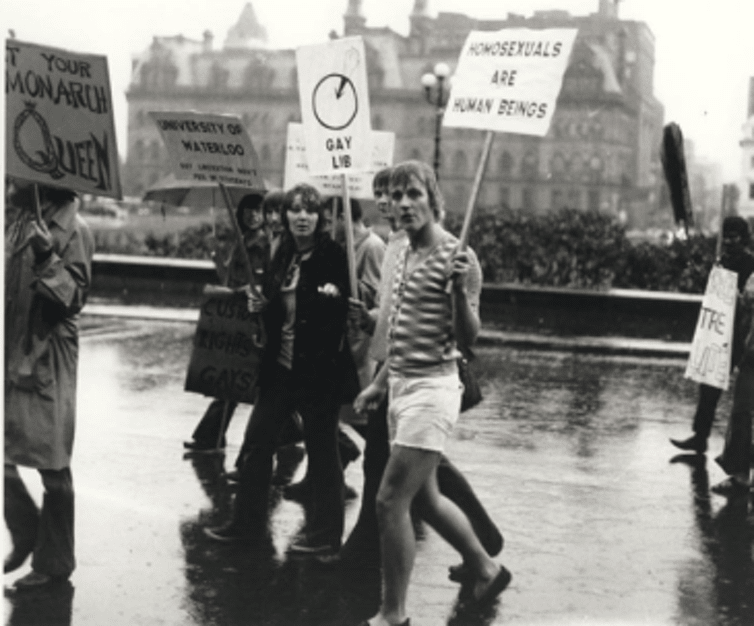
Rather than denounce the military as did their American counterparts who tied gay liberation to the struggle against imperialism, they demanded the end of their exclusion from it. Instead of calling marriage a rotten institution, Canadian activists insisted on the right to enjoy the financial and other benefits it conferred.
Seen through the lens of the 1971 “We Demand” protest, 1969 really does look like the starting point of five decades of the struggle for lesbian and gay equality in Canada.
Those same protesters were about to become much more radical in their politics, however. Frustrated that the media refused to cover their protest or report their demands, they launched The Body Politic, a newspaper that became one of the most important journals of the international gay liberationist movement.
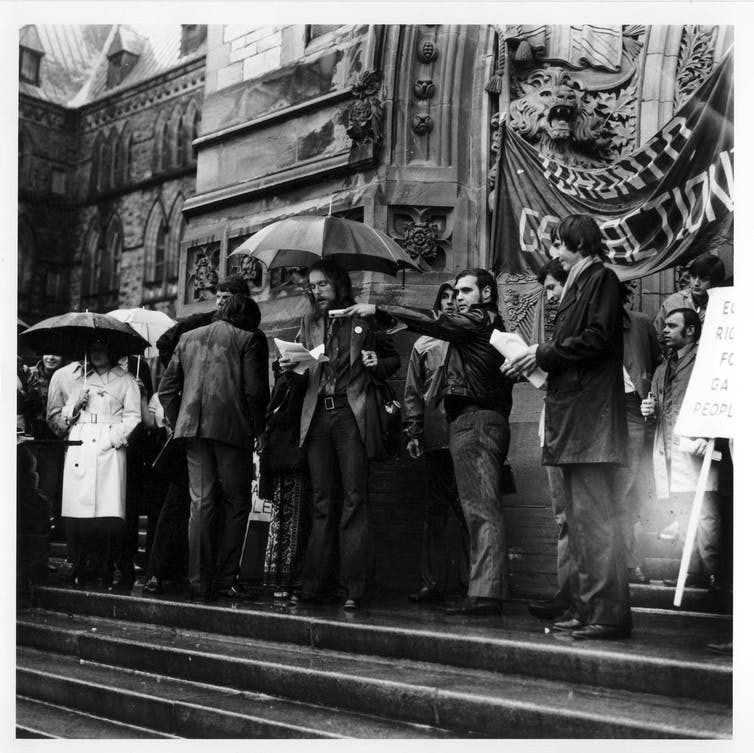
Equity replaced liberation
Published from 1971 to 1987, The Body Politic contributors offered incisive critiques of the nuclear family, the church and the state as the key proponents of gender and sexual oppression. Radical liberationists tried to live their ideals by creating collective organizations, including households.
Yet the persistence of everyday forms of discrimination could not be ignored. Bill C-150 left intact the right to discriminate against Canadians on the basis of sexual orientation.
Lesbians and gays were fired simply for being gay. The robust social benefits citizenship conferred to heterosexuals such as the survivor’s pension (then called widow’s pension) were denied to same-sex couples.
When in 1982, the same Pierre Elliot Trudeau patriated Canada’s Constitution, protection from discrimination based on sexual orientation was deemed unworthy of inclusion in the Charter of Rights and Freedoms.
And lesbians and gays remained barred from joining the military. It would take another 20 years before all of the demands made in 1971 would be met.
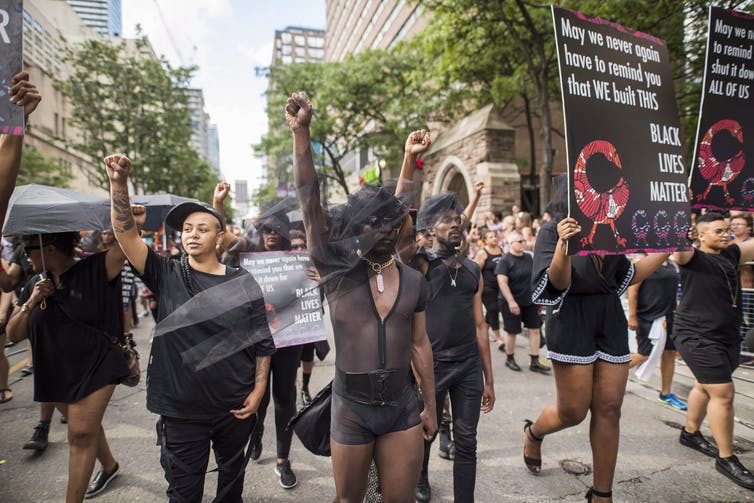
Radicals dreamed of liberation, but what we got was equality. How we got it, the protesters rightly point out, is due far more to the effort of activists on the ground than to prime ministerial pronouncements on the Hill.
But the real missing element in this story is the disappearance of the radical vision of a society based on principles of love and human dignity, a society that rejects hierarchy, rejects sexism, rejects racism, rejects gains made by one at the expense of another. If these are the principles that guide us, then the link between LBGTQ experience and the struggles of other forms of sexual marginalization and oppression becomes obvious.
The ease with which queer life has been and still can be disregarded shares a common root with the disregard we see today toward, for example, murdered and missing girls and women and sex workers of all genders and orientations. Those of us who have made appreciable gains from 50 years of slow but steady progress must use our newfound privilege to shine a light on the hierarchies of oppression that persist.
Elise Chenier, Professor, Simon Fraser University
This article is republished from The Conversation under a Creative Commons license. Read the original article.
![]()


